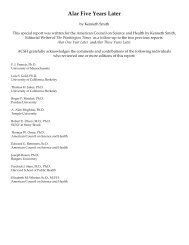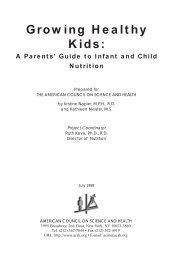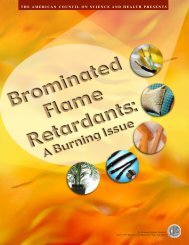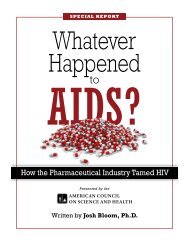The Role of Beef in the American Diet - International Meat Secretariat
The Role of Beef in the American Diet - International Meat Secretariat
The Role of Beef in the American Diet - International Meat Secretariat
Create successful ePaper yourself
Turn your PDF publications into a flip-book with our unique Google optimized e-Paper software.
<strong>The</strong> <strong>Role</strong> <strong>of</strong> <strong>Beef</strong> <strong>in</strong> <strong>the</strong> <strong>American</strong> <strong>Diet</strong><br />
Concerns have been raised about two classes <strong>of</strong> products used <strong>in</strong><br />
food animal production — hormones and antibiotics. <strong>The</strong> follow<strong>in</strong>g sections<br />
present up-to-date <strong>in</strong>formation on <strong>the</strong>se topics.<br />
Hormones<br />
Three natural and three syn<strong>the</strong>tic steroid hormones have been<br />
approved for use at very low concentrations to <strong>in</strong>crease <strong>the</strong> rate <strong>of</strong><br />
weight ga<strong>in</strong> <strong>in</strong> beef cattle (42). <strong>The</strong>se hormones are used because <strong>the</strong>y<br />
allow cattle producers to raise animals on a smaller amount <strong>of</strong> feed, thus<br />
lower<strong>in</strong>g <strong>the</strong> cost <strong>of</strong> beef for consumers. <strong>The</strong> hormones are adm<strong>in</strong>istered<br />
<strong>in</strong> an implant <strong>in</strong> <strong>the</strong> ear, an <strong>in</strong>edible part <strong>of</strong> <strong>the</strong> animal.<br />
<strong>The</strong>re is no risk to consumers from eat<strong>in</strong>g meat from animals treated<br />
with natural hormones because <strong>the</strong> amounts <strong>of</strong> hormones left <strong>in</strong> <strong>the</strong><br />
meat are very low <strong>in</strong> comparison with <strong>the</strong> amounts naturally present <strong>in</strong><br />
<strong>the</strong> human body (42). For example, a three-ounce serv<strong>in</strong>g <strong>of</strong> beef from<br />
an animal treated with <strong>the</strong> natural hormone estradiol (estrogen) conta<strong>in</strong>s<br />
1.9 nanograms <strong>of</strong> estrogen; <strong>the</strong> same amount <strong>of</strong> meat from an<br />
untreated animal would conta<strong>in</strong> 1.2 nanograms. A nanogram is one billionth<br />
<strong>of</strong> a gram. Although <strong>the</strong> meat from <strong>the</strong> treated animal does conta<strong>in</strong><br />
more estrogen, <strong>the</strong> difference (less than one billionth <strong>of</strong> a gram) is<br />
negligible <strong>in</strong> comparison to <strong>the</strong> 136,000 nanograms produced each day<br />
<strong>in</strong> a man’s body or <strong>the</strong> 480,000 nanograms produced daily <strong>in</strong> a<br />
w o m a n ’s body (43). <strong>The</strong> total amount <strong>of</strong> estrogen <strong>in</strong> a serv<strong>in</strong>g <strong>of</strong> beef<br />
from a treated animal is also low <strong>in</strong> comparison with <strong>the</strong> amount naturally<br />
present <strong>in</strong> animal products such as eggs and milk or <strong>the</strong> amount <strong>of</strong><br />
plant estrogens found <strong>in</strong> foods such as wheat germ and soybean oil, all<br />
<strong>of</strong> which are safe (44).<br />
<strong>The</strong> situation with syn<strong>the</strong>tic hormones is slightly different, s<strong>in</strong>ce<br />
<strong>the</strong>se hormones are not naturally produced. However, <strong>the</strong>y too have<br />
been evaluated for safety. Before <strong>the</strong>se hormones were approved, <strong>the</strong><br />
Food and Drug Adm<strong>in</strong>istration required extensive toxicological test<strong>in</strong>g<br />
<strong>in</strong> animals to determ<strong>in</strong>e safe levels <strong>in</strong> edible tissues (42). <strong>The</strong> manufacturers<br />
were also required to demonstrate that <strong>the</strong> amount <strong>of</strong> hormone<br />
left <strong>in</strong> edible tissues after treatment was with<strong>in</strong> <strong>the</strong> safety limit (42).<br />
Antibiotics<br />
Antibiotics are used <strong>in</strong> animals <strong>in</strong> much <strong>the</strong> same ways that <strong>the</strong>y are<br />
used <strong>in</strong> humans — that is, to treat or prevent bacterial diseases. <strong>The</strong>y<br />
may also be used <strong>in</strong> low doses to enhance growth and feed efficiency<br />
(<strong>the</strong> amount that an animal grows on a given amount <strong>of</strong> feed). Antibiotics<br />
may enhance feed efficiency at least <strong>in</strong> part by allow<strong>in</strong>g <strong>the</strong> ani-<br />
21










